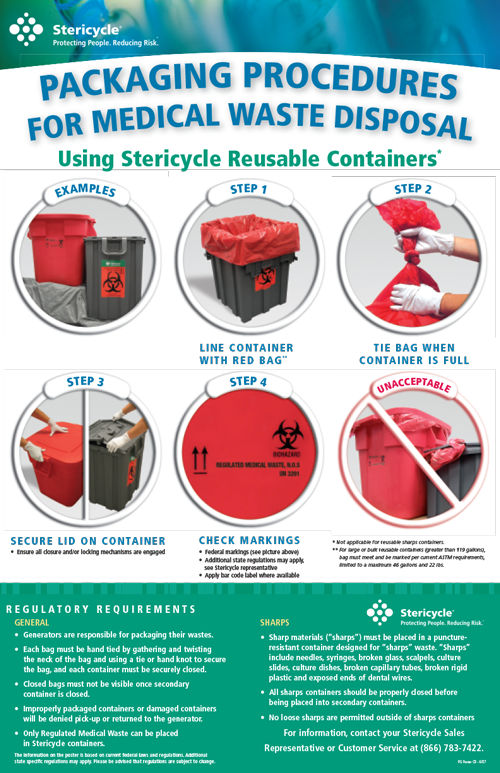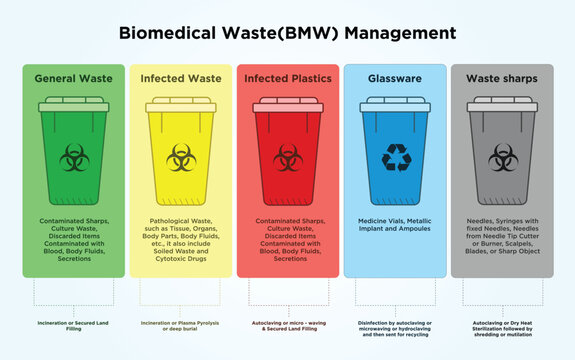Compliance and Rules for Medical Garbage Disposal
Conformity and laws for medical waste disposal play a vital role in guaranteeing the safety and security and health of both health care experts and the general public. Correct administration of medical waste is important to stop the spread of infections, safeguard the atmosphere, and preserve public health and wellness. These regulations encompass various facets, consisting of the category and segregation of clinical waste, appropriate storage space and taking care of procedures, as well as transportation and disposal techniques.
Importance of Compliance
The significance of compliance with regulations for medical waste disposal can not be overstated. Appropriate disposal of clinical waste is critical for making certain the safety and security and health of healthcare workers, clients, and the general public. Medical waste, which consists of things such as made use of needles, polluted gloves, and biomedical waste, can position major health threats otherwise managed and thrown away appropriately.
Compliance with policies ensures that clinical waste is handled in a way that minimizes the possibility for exposure to infectious conditions and dangerous compounds - medical waste removal. It aids stop the spread of infections, such as HIV, hepatitis B and C, and various other bloodborne pathogens. Conformity likewise plays a vital function in safeguarding the setting by avoiding contamination of water resources, soil, and air
Failing to conform with laws can lead to severe repercussions for healthcare facilities, consisting of fines, lawful action, and damages to their credibility. In addition, non-compliance may endanger the health and wellness of healthcare employees, patients, and the neighborhood.
Conformity with regulations for clinical garbage disposal requires adherence to certain standards and protocols. These might consist of proper segregation, product packaging, labeling, and storage of medical waste. It additionally involves utilizing accepted disposal approaches, such as autoclaving, incineration, or landfilling, relying on the sort of waste.
Regulatory Agencies and Bodies
Regulative companies and bodies play a crucial role in supervising conformity with laws for clinical waste disposal. These organizations are in charge of setting criteria, guidelines, and methods to ensure the secure and appropriate handling of medical waste. They apply and monitor conformity to protect public wellness and the environment.
One of the most prominent governing agencies in the USA is the Epa (EPA) The EPA is accountable for regulating the storage space, transport, therapy, and disposal of clinical waste. They establish standards for waste generators, transporters, and treatment facilities to follow, guaranteeing that all necessary precautions are required to stop the spread of illness and contamination.
One more important governing body is the Occupational Safety And Security and Health And Wellness Administration (OSHA) OSHA establishes requirements and policies to safeguard workers from job-related dangers, including those pertaining to medical waste. WasteX Medical Waste Disposal. They provide standards for the safe handling and disposal of clinical waste to safeguard staff members in health care centers
In enhancement to these federal firms, individual states likewise have their own regulative bodies that oversee medical garbage disposal. These agencies might have their very own particular laws and requirements that have to be followed.

Classification and Segregation of Clinical Waste
To guarantee appropriate management of medical waste, it is crucial to classify and segregate it according to developed procedures and standards. medical waste disposal. Category and partition play an essential duty in minimizing the danger of infection, shielding the environment, and guaranteeing the safety and security of medical care workers and the general public
Medical waste is categorized right into various groups based on its potential risk level. These classifications consist of transmittable waste, pathological waste, sharps waste, pharmaceutical waste, chemical waste, and radioactive waste. Each category requires particular handling, transport, storage space, and disposal techniques to lessen the danger of direct exposure and contamination.
Partition of clinical waste entails dividing various kinds of waste at the resource. This process makes sure that waste with various threat degrees is not combined, lowering the potential for cross-contamination and making disposal procedures more reliable. Correct segregation is accomplished via using color-coded tags and containers, which aid medical care employees and waste administration personnel recognize and take care of each type of waste appropriately.
Along with category and partition, healthcare facilities must likewise stick to local, state, and government guidelines regarding clinical waste management. These guidelines describe specific requirements for storage space, transportation, therapy, and last disposal navigate to this website of clinical waste, making certain conformity and keeping public wellness and security.
Appropriate Storage and Managing Procedures
Correct storage space and dealing with procedures play a vital role in ensuring the compliant and safe monitoring of medical waste. Medical waste, which consists of products such as used syringes, infected handwear covers, and expired drugs, can present major wellness and ecological risks otherwise dealt with correctly. Consequently, it is vital for healthcare centers and other generators of medical waste to carry out strict storage space and dealing with methods.
To begin with, clinical waste ought to be kept in durable, watertight containers that are especially developed for this objective. These containers ought to be classified with the universal biohazard sign and words "medical waste" to clearly show the contents. Furthermore, the containers need to be kept safely near prevent any type of possible leakage or spillage.
Moreover, it is important to segregate different kinds of clinical waste to stop cross-contamination. Sharps, such as scalpels and needles, need to be stored in puncture-resistant containers to reduce the danger of injuries - WasteX Medical Waste Disposal. Chemical waste, such as anti-bacterials and solvents, need to be stored separately from other types of medical waste to avoid chain reactions or harmful direct exposures

Transportation and Disposal Techniques
Healthcare centers need to ensure the secure transportation and proper disposal of their medical waste to abide by guidelines and protect public health. Transportation and disposal techniques play a vital role in protecting against the spread of infectious diseases and lessening the environmental impact of clinical waste.
To transport medical waste, medical care centers ought to use puncture-resistant and watertight containers that are identified with the biohazard sign. These containers should be safely secured to stop any type of leak during transportation. In addition, health care facilities ought to develop procedures for the transportation procedure, including the use of devoted automobiles and experienced employees.
When the medical waste gets to the disposal center, it undertakes different approaches of treatment. One common approach is incineration, which involves melting the waste at heats to ruin pathogens and lower the quantity of waste. Another approach is autoclaving, which uses heavy steam and stress to disinfect the waste. After therapy, the waste is normally sent to a land fill or a waste-to-energy center for last disposal.
It is vital for health care centers to function with qualified and allowed waste monitoring firms to make certain correct transport and disposal of clinical waste. These business have the expertise and resources to handle clinical waste securely and in conformity with guidelines.
Final Thought
In final thought, compliance with policies for medical garbage disposal is of utmost relevance to make certain public wellness and security. Regulative agencies and bodies play an essential role in applying these laws. Appropriate classification and partition of clinical waste, in addition to following ideal storage space and managing procedures, are essential to protect against contamination and the spread of illness. Sufficient transport and disposal techniques should be implemented to decrease environmental impacts. Generally, adherence to compliance and laws is needed to efficiently take care of medical waste.
Medical waste, which consists of items such as made use of needles, contaminated handwear covers, and biomedical waste, can pose severe wellness dangers if not taken care of and disposed of correctly.
These groups include contagious waste, pathological waste, sharps waste, pharmaceutical waste, chemical waste, and contaminated waste.Segregation of medical waste entails separating different kinds of waste at the resource. Proper segregation is attained through the use of color-coded containers and tags, which help health care employees and waste management workers identify and manage each type of waste properly.
Chemical waste, such as anti-bacterials and solvents, should be kept separately from other kinds of clinical waste to avoid chemical reactions or harmful direct exposures.